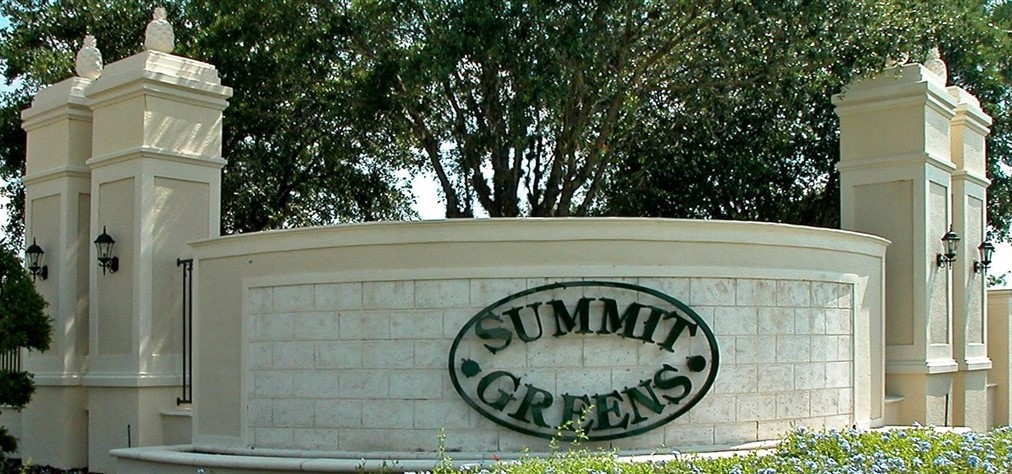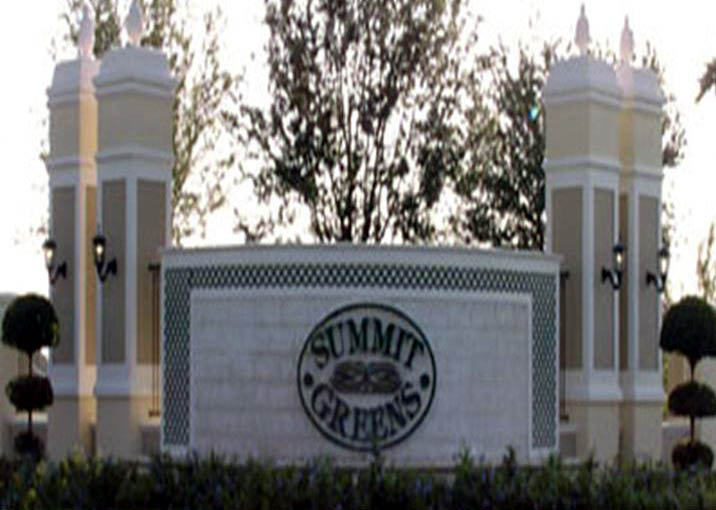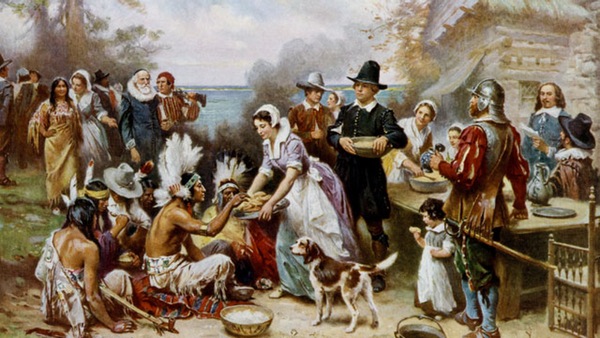 The story of the first Thanksgiving is filled with folklore and legend. But what’s the real story? Here are 10 commonly believed myths about the First Thanksgiving debunked.
The story of the first Thanksgiving is filled with folklore and legend. But what’s the real story? Here are 10 commonly believed myths about the First Thanksgiving debunked.
1. Myth: The First Thanksgiving lasted only one day.
Fact: It lasted three days!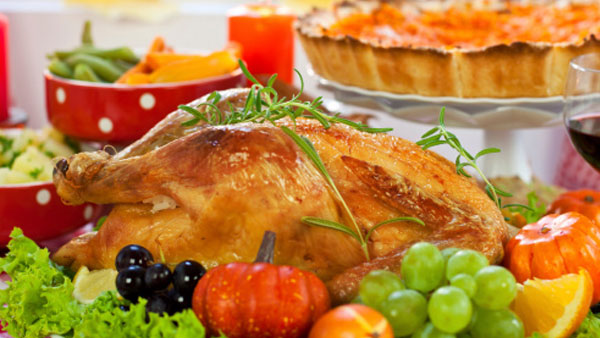 The typical one-day celebration that Americans now enjoy for Thanksgiving wouldn’t have cut it for the Pilgrims. One day of celebrating just wasn’t enough for our ancestors, so they turned it into a three-day celebration. The first successful harvest was so bountiful that it lasted the Pilgrims and Native Americans for three days and included wheat, corn, barley, and maybe peas, not forgetting the venison, turkeys, waterfowl, cod, and bass. And of course the sides and sweets can’t be forgotten: clams, mussels, lobster, eel, nuts, walnuts, chestnuts, squashes, beans, strawberries, raspberries, grapes, and gooseberries. Talk about a food coma!
The typical one-day celebration that Americans now enjoy for Thanksgiving wouldn’t have cut it for the Pilgrims. One day of celebrating just wasn’t enough for our ancestors, so they turned it into a three-day celebration. The first successful harvest was so bountiful that it lasted the Pilgrims and Native Americans for three days and included wheat, corn, barley, and maybe peas, not forgetting the venison, turkeys, waterfowl, cod, and bass. And of course the sides and sweets can’t be forgotten: clams, mussels, lobster, eel, nuts, walnuts, chestnuts, squashes, beans, strawberries, raspberries, grapes, and gooseberries. Talk about a food coma!
2. Myth: The Pilgrims enjoyed a plentiful bounty of corn.
Fact: They enjoyed “turkey wheat.”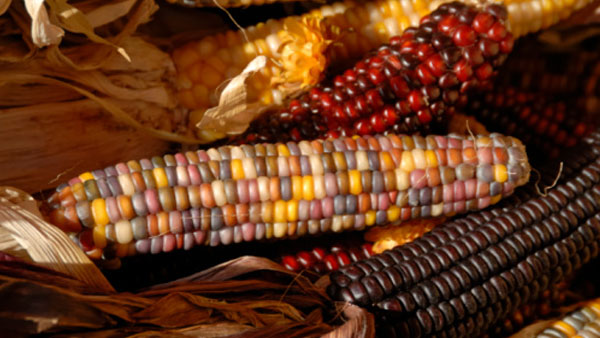 OK, we call it corn today, but in the 17th century corn meant rye, barley, oats, or other grains, not the corn we know and love today. During the 1600s, they most likely called it “Indian corn” (to what we normally call the beautifully fall-colored kernels shown above) or simply “turkey wheat.” The bounty was so plentiful thanks to Squanto and the Native Americans that it could last each person of Plymouth Plantation a week, according to William Bradford’s account: “Besides, they had about a peck of meal a week to a person, or now since harvest, Indian corn to that proportion. Which made many afterwards write so largely of their plenty here to their friends in England, which were not feigned but true reports.”
OK, we call it corn today, but in the 17th century corn meant rye, barley, oats, or other grains, not the corn we know and love today. During the 1600s, they most likely called it “Indian corn” (to what we normally call the beautifully fall-colored kernels shown above) or simply “turkey wheat.” The bounty was so plentiful thanks to Squanto and the Native Americans that it could last each person of Plymouth Plantation a week, according to William Bradford’s account: “Besides, they had about a peck of meal a week to a person, or now since harvest, Indian corn to that proportion. Which made many afterwards write so largely of their plenty here to their friends in England, which were not feigned but true reports.”
3. Myth: The Plymouth settlers were called Pilgrims.
Fact: The word “pilgrim” wasn’t coined for the settlers until 200 years later!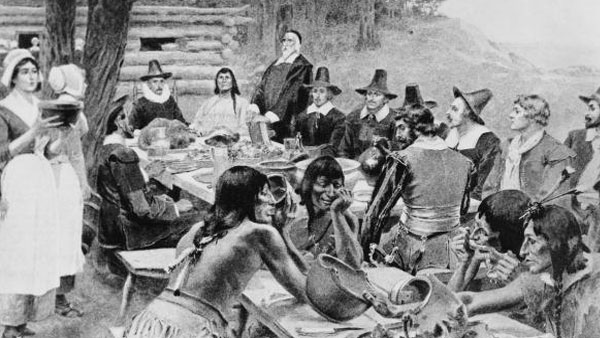 When the settlers first arrived in America they were called “Old Comers” or “First Comers” and then referred to as simply the Forefathers. It wasn’t until two centuries later that a manuscript of Bradford’s was discovered in which he referred to the Old Comers as “saints” who left Holland as “pilgrimes.” At the bicentennial celebration in 1820, the famed orator Daniel Webster used the phrase “Pilgrim Fathers” and colloquially shortened to simply Pilgrims. The term has been used ever since.
When the settlers first arrived in America they were called “Old Comers” or “First Comers” and then referred to as simply the Forefathers. It wasn’t until two centuries later that a manuscript of Bradford’s was discovered in which he referred to the Old Comers as “saints” who left Holland as “pilgrimes.” At the bicentennial celebration in 1820, the famed orator Daniel Webster used the phrase “Pilgrim Fathers” and colloquially shortened to simply Pilgrims. The term has been used ever since.
4. Myth: Thanksgiving has been celebrated in some form or another ever since that first day.
Fact: The Thanksgiving holiday wasn’t celebrated until 1827.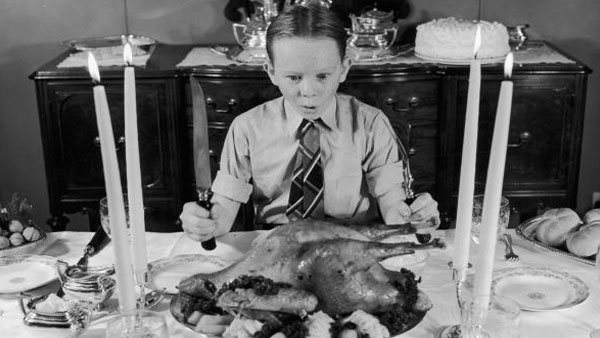 The Pilgrims never celebrated or even commemorated Thanksgiving in any year thereafter. The closest holiday celebrated by the settlers’ descendants was called “Forefather’s Day” and took place closer to Christmas. George Washington made the first Thanksgiving address, but never established the time-honored holiday and Americans didn’t keep the tradition. It wasn’t until 1827 that the efforts of Sarah Josepha Hale, an influential writer and editor, finally paid off and the holiday was created. In 1863, Abraham Lincoln officially made Thanksgiving a national holiday. However, it still wasn’t recognized as the holiday we know and love today. It would take another 76 years in 1939 before President Franklin Roosevelt designated the fourth Thursday in November as Thanksgiving.
The Pilgrims never celebrated or even commemorated Thanksgiving in any year thereafter. The closest holiday celebrated by the settlers’ descendants was called “Forefather’s Day” and took place closer to Christmas. George Washington made the first Thanksgiving address, but never established the time-honored holiday and Americans didn’t keep the tradition. It wasn’t until 1827 that the efforts of Sarah Josepha Hale, an influential writer and editor, finally paid off and the holiday was created. In 1863, Abraham Lincoln officially made Thanksgiving a national holiday. However, it still wasn’t recognized as the holiday we know and love today. It would take another 76 years in 1939 before President Franklin Roosevelt designated the fourth Thursday in November as Thanksgiving.
5. Myth: Thanksgiving is celebrated on the same day as the Pilgrims celebration.
Fact: Bluntly put, NO. November is far too late in the season to enjoy a plentiful harvest. The Pilgrims most likely celebrated the First Thanksgiving some time between September and early November.
November is far too late in the season to enjoy a plentiful harvest. The Pilgrims most likely celebrated the First Thanksgiving some time between September and early November.
So why do we celebrate it in late November?
The day is believed to be related to the date on which the Mayflower set anchor at Cape Cod: Nov. 21, 1620. Fun fact: the Pilgrims still used the Julian calendar, so the date based on the modern Gregorian calendar that we use today would be Nov. 11.
6. Myth: A giant bird was the dinner staple.
Fact: The turkey we eat today is much different than that of the 17th century.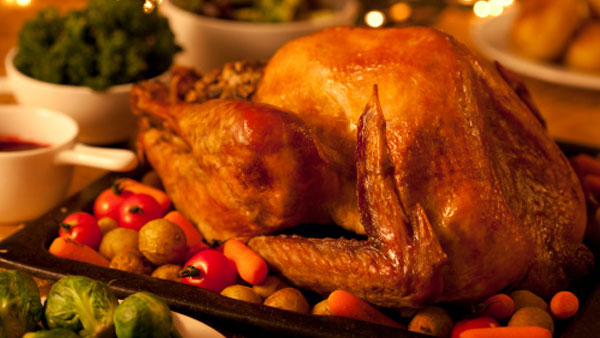 Today we eat what is known as “domestic turkey.” This turkey is giant compared to the wild turkey the Pilgrims might have eaten (a large, plump bird would have weighed perhaps eight pounds). Despite an abundance of such turkeys near the settlement, there is no written account of the Pilgrims eating turkey. The two accounts published, one by Bradford and the other by Edward Winslow, only mention wild fowl, most likely referring to geese or duck. Even so, these birds wouldn’t have been enough to fully satisfy the entire colony. So what did the Old Comers do? They threw in some more meat like venison and some seafood, along with a wide range of pies from savory to sweet, which of course would last them through their three-day celebration.
Today we eat what is known as “domestic turkey.” This turkey is giant compared to the wild turkey the Pilgrims might have eaten (a large, plump bird would have weighed perhaps eight pounds). Despite an abundance of such turkeys near the settlement, there is no written account of the Pilgrims eating turkey. The two accounts published, one by Bradford and the other by Edward Winslow, only mention wild fowl, most likely referring to geese or duck. Even so, these birds wouldn’t have been enough to fully satisfy the entire colony. So what did the Old Comers do? They threw in some more meat like venison and some seafood, along with a wide range of pies from savory to sweet, which of course would last them through their three-day celebration.
Fun fact: Benjamin Franklin loved turkey so much and thought the bird so magnificent that he lobbied to have it be our national bird. (It’s a good thing his lobby failed and the bald eagle became our national bird, as it might have made it difficult to eat a national symbol.)
7. Myth: The Pilgrims invited the Native Americans to the harvest.
Fact: Written accounts tell a much different story.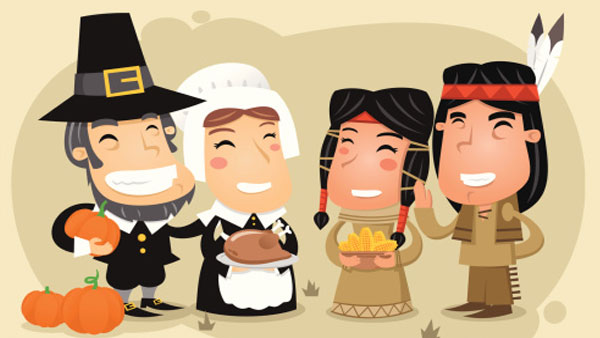 There are only two written accounts of the First Thanksgiving and neither imply that Pilgrims invited the Native Americans to partake in their celebration. The Wampanoag Indians were certainly present at the feast, but the wording implies that they simply happened to show up rather than be invited. Some historians have suggested that they even showed up in full warrior garb because the Pilgrims were shooting off guns and hollering about out of celebration and so the Wampanoags thought they would be attacked. No account can verify this suggestion either, which leaves us to believe that the Native Americans “crashed the party.” However, because of the typical festivities surrounding celebrations during the era, the Pilgrims most likely were making lots of noise and the Indians came to investigate, at which point they were “invited” to participate in the festivities.
There are only two written accounts of the First Thanksgiving and neither imply that Pilgrims invited the Native Americans to partake in their celebration. The Wampanoag Indians were certainly present at the feast, but the wording implies that they simply happened to show up rather than be invited. Some historians have suggested that they even showed up in full warrior garb because the Pilgrims were shooting off guns and hollering about out of celebration and so the Wampanoags thought they would be attacked. No account can verify this suggestion either, which leaves us to believe that the Native Americans “crashed the party.” However, because of the typical festivities surrounding celebrations during the era, the Pilgrims most likely were making lots of noise and the Indians came to investigate, at which point they were “invited” to participate in the festivities.
8. Myth: Turkeys got their name from the sound they make, which sometimes sounds like “Turk turk turk.”
Fact: Turkeys were named after their importers-the Ottoman Turks.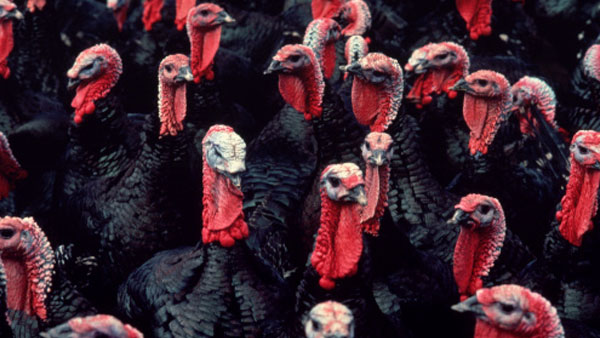 In the 16th century, a new bird was introduced to Europe by the Ottoman Empire called the guinea fowl. The merchants, Turks, were known as “turkey merchants” and so the birds were soon referred to as “turkey fowl.” The American turkey was thought to be a type of guinea fowl and so the same name was applied to the North American turkey. The North American turkey is a different species than guinea fowl, but the name stuck and is continued to be used today.
In the 16th century, a new bird was introduced to Europe by the Ottoman Empire called the guinea fowl. The merchants, Turks, were known as “turkey merchants” and so the birds were soon referred to as “turkey fowl.” The American turkey was thought to be a type of guinea fowl and so the same name was applied to the North American turkey. The North American turkey is a different species than guinea fowl, but the name stuck and is continued to be used today.
9. Myth: The First Thanksgiving was about giving thanks to God.
Fact: The First Thanksgiving was actually just a harvest celebration.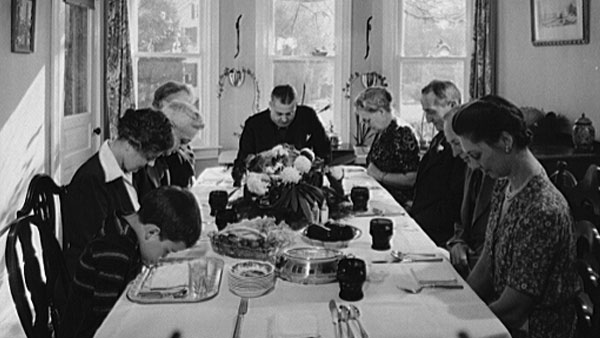 What?! How could you say that?! The Pilgrims were religious! They fled Europe because of religious persecution for heaven’s sake!
What?! How could you say that?! The Pilgrims were religious! They fled Europe because of religious persecution for heaven’s sake!
Yes, all true. But keep in mind that the Pilgrims were staunch and even radical Puritans, more technically called Separatists. What was this group best known for? Their puritanical views, of course! Which includes not making religion a celebration or “fun.” A celebration that included fun and games and drinking would not have been considered a religious holiday to the Pilgrims. Thanksgiving Holidays were religious days devoted to God and the Pilgrims did indeed have Thanksgiving holidays dedicated to giving thanks to God, but the day we celebrate as Thanksgiving was not considered a Thanksgiving holiday to the Pilgrims. They celebrated various Thanksgivings throughout the year that were highly religious affairs, which meant everyone was in church and everyone was praying – not out celebrating the harvest.
10. Myth: Our Thanksgiving is the same as the Pilgrims.
Fact: We’ve combined two traditions into one. Today’s national Thanksgiving holiday blends the tradition of celebrating after a bountiful harvest – which in and of itself is based on the ancient English tradition of harvest festivals – and the Puritan Thanksgiving holiday or religious observance full of prayer, feasting, and church-going. Today, we might not be giving thanks for a bountiful harvest, or even celebrating it, but we do give thanks for the many blessings in our life, from family and home to successes and that big, fat turkey that’s sitting in the middle of the dinner table.
Today’s national Thanksgiving holiday blends the tradition of celebrating after a bountiful harvest – which in and of itself is based on the ancient English tradition of harvest festivals – and the Puritan Thanksgiving holiday or religious observance full of prayer, feasting, and church-going. Today, we might not be giving thanks for a bountiful harvest, or even celebrating it, but we do give thanks for the many blessings in our life, from family and home to successes and that big, fat turkey that’s sitting in the middle of the dinner table.
Compliments of StaffWarrior
